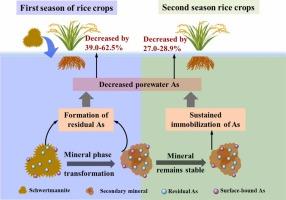Schwertmannite在淹水水稻土中保持砷的有效稳定:来自两季水稻实验和潜在机制的见解
IF 11.3
1区 环境科学与生态学
Q1 ENGINEERING, ENVIRONMENTAL
引用次数: 0
摘要
水稻(Oryza sativa L.)易在籽粒中积累高含量的砷,威胁食品安全和人类健康。Schwertmannite (Sch)由于具有较高的As吸附能力,被认为是一种潜在的土壤改进剂,可以缓解水稻土中As的积累。然而,由于schwertmannite的亚稳态和水稻土的高铁还原电位,schwertmannite是否能保持对As的持续稳定作用,以及这种稳定的潜在机制尚不清楚。本研究通过水稻盆栽两季试验,评价了施韦特曼酸一次性施用对砷污染水稻土的可持续修复潜力,并在实验室条件下进一步探讨了施韦特曼酸对土壤砷持续滞留的机制。结果表明,与对照相比,施0.5 ~ 1% (w/w)施韦尔曼石在第1季和第2季分别使籽粒As积累量减少60.1 ~ 62.5%和27.0 ~ 28.9%。一方面,次生矿物对砷保持了一定的吸附能力(8.85 ~ 16.08 mg/g),对砷进行了连续的固定化。另一方面,在许氏锰矿或次生矿物上形成大量残余As(90.0 ~ 98.8%),增强了固体矿物稳定保留As的能力,从而降低了As再释放的风险。此外,次生矿物在还原环境中不发生相变,有利于维持矿物结构和固体矿物结构中残余砷的稳定存在。这些研究结果对两季水稻栽培中施韦曼石有效固定砷的机制有重要意义,对施韦曼石在砷污染水稻土修复中的实际应用具有重要意义。数据可得性应要求提供数据。本文章由计算机程序翻译,如有差异,请以英文原文为准。

Schwertmannite maintains effective stabilization of arsenic in flooded paddy soil: Insights from a two-season rice experiment and underlying mechanisms
Rice (Oryza sativa L.) tends to accumulate elevated levels of arsenic (As) in grain, threatening food safety and human health. Schwertmannite (Sch), with its high As adsorption capacity, has been suggested as a potential soil amendment to mitigate As accumulation in paddy soils. However, due to the metastable state of schwertmannite and the high iron reduction potential of paddy soil, it remains unclear whether schwertmannite can maintain a persistent stabilizing effect on As, as well as the underlying mechanisms of such stabilization. In this study, two-season pot experiments with rice were conducted to evaluate the potential of one-time application of schwertmannite for sustainable remediation of As-contaminated paddy soil, and the mechanism underlying its persistent retention of soil As was further investigated under laboratory conditions. It was found that, compared with the corresponding control, the application of 0.5-1% (w/w) schwertmannite reduced As accumulation in grains by 60.1–62.5% in the first growing season and by 27.0–28.9% in the second season. On the one hand, secondary minerals maintained a certain adsorption capacity for As (8.85-16.08 mg/g), thus continuously immobilizing As. On the other hand, the formation of a considerable amount of residual As (90.0-98.8%) on schwertmannite or secondary minerals enhanced the ability of solid minerals to stably retain As, thereby reducing the risk of As re-release. In addition, secondary minerals did not undergo phase transformation in a reducing environment, which was beneficial for maintaining the mineral structure and the stable presence of residual As in the solid mineral structure. These findings provide valuable insights into the mechanisms by which schwertmannite effectively immobilizes As in two-season rice cultivation, and hold important implications for its practical application in the remediation of arsenic-contaminated paddy soils.
Data availability
Data will be made available on request.求助全文
通过发布文献求助,成功后即可免费获取论文全文。
去求助
来源期刊

Journal of Hazardous Materials
工程技术-工程:环境
CiteScore
25.40
自引率
5.90%
发文量
3059
审稿时长
58 days
期刊介绍:
The Journal of Hazardous Materials serves as a global platform for promoting cutting-edge research in the field of Environmental Science and Engineering. Our publication features a wide range of articles, including full-length research papers, review articles, and perspectives, with the aim of enhancing our understanding of the dangers and risks associated with various materials concerning public health and the environment. It is important to note that the term "environmental contaminants" refers specifically to substances that pose hazardous effects through contamination, while excluding those that do not have such impacts on the environment or human health. Moreover, we emphasize the distinction between wastes and hazardous materials in order to provide further clarity on the scope of the journal. We have a keen interest in exploring specific compounds and microbial agents that have adverse effects on the environment.
 求助内容:
求助内容: 应助结果提醒方式:
应助结果提醒方式:


